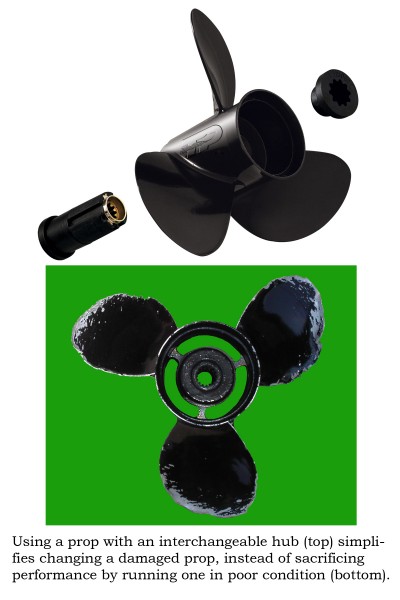
Props can take a beating in even the best conditions. Churning sand, mud, floating debris, logs and rocks can bend, chip or crack blades. Even minor nicks, dings or scratches that accumulate from normal wear-and-tear can rapidly degrade performance. Running a damaged or bent propeller has the same effect as driving on worn or poorly inflated tires─you have less control, and performance and efficiency suffer.
Worse yet, continuing to use a bent or cracked prop can damage the engine’s gearcase. A compromised propeller will not spin true, creating excessive vibration that can have devastating results.
With this in mind, propellers should be inspected regularly for damage. Spring commissioning and fall layup are great times for a close look. Trailered boats can easily be examined prior to each trip.
Signs of severe wear, such as chipping or cracks on the blade tips or cracks along the blade joints, are easiest to spot. Another important but less obvious item to inspect is the propeller’s pitch, as the blade angles can become bent or offset over time. If propeller blades seem out of alignment, it’s best to have them inspected by a local prop specialist.
Apart from regular prop inspections, if while running the boat you hit something or tangle up in thick weeds, examine the prop as soon as possible. If you heard it or felt it, damage is highly likely. This is also why a spare prop should be an essential onboard piece of equipment.
When prop damage occurs, the question is whether to repair or replace. Propeller repair can be expensive, especially on hard-to-weld stainless steel. Blades that are ground down to remove bent or chipped edges create subtle changes in prop pitch and diameter that can degrade performance. And, few prop shops can guarantee same-day service, especially in the heart of boating season. This leaves you off the water.
However, if the damaged prop has a removable hub, the housing can instead be replaced for about the price of a repair. Why repair a prop and contend with performance issues when a brand new one can be installed for a comparable price, putting you back on the water the same day?
There also are good reasons to replace an older propeller that is still in good condition. Changes in hull design and the introduction of high horsepower outboards have led to radical new approaches to propeller design and manufacturing. In addition, computer modeling has resulted in a better understanding of fluid dynamics and high-velocity water flow. Advances such as variable rake and pitch blades, multiple geometries and new barrel designs have rendered older propellers obsolete in terms of hydrodynamic efficiency.
Choosing the appropriate propeller for a particular boat and motor is fairly simple. The most important equation to understand is that less pitch means more rpm and more pitch means less rpm. For peak performance, an engine should run at the upper end of the manufacturer’s recommended rpm range, or WOT. If more speed, handling and lift are desired, particular prop styles come into play. The normal load on the boat, as well as whether the craft is usually used for fishing, watersports or cruising, also factors in prop selection. Turning Point’s online Prop Wizard tool helps you select the best prop for your boat/engine set-up.
To help keep your boat running its best, replacing a propeller is quick, easy and inexpensive for models with an interchangeable hub system. Any damaged blade requires only that the housing be replaced, not the entire prop, saving hundreds of dollars over the years.
 Your Privacy Choices
Your Privacy Choices
 The
The